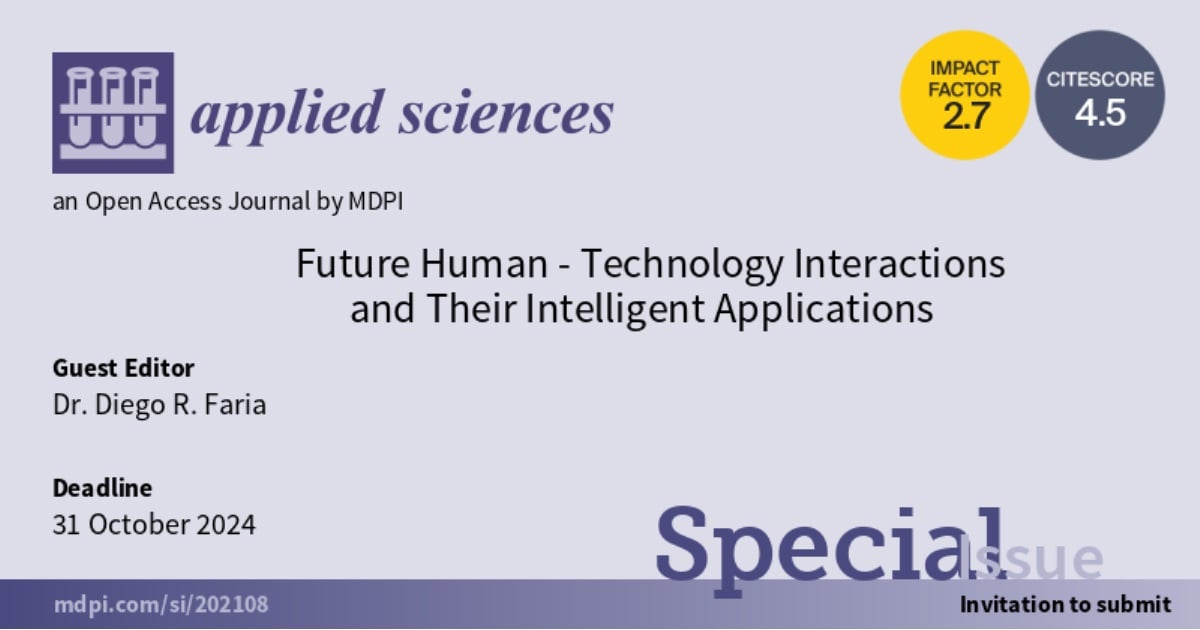Future Human-Technology Interactions and Their Intelligent Applications
A special issue of Applied Sciences (ISSN 2076-3417). This special issue belongs to the section "Robotics and Automation".
Deadline for manuscript submissions: 31 October 2024 | Viewed by 883

Special Issue Editor
Interests: robotics; pattern recognition; brain-computer interfaces; applied machine learning
Special Issues, Collections and Topics in MDPI journals
Special Issue Information
Dear Colleagues,
The domain of human–technology interaction stands at the forefront of innovation, driving progress in fields such as affective intelligence, applied machine learning, assistive technology, and robotics. This synergy between human and machine holds immense promise for enhancing various aspects of human life, spanning healthcare, education, smart cities, and beyond. Within this dynamic landscape, the exploration of interdisciplinary topics becomes imperative, paving the way for groundbreaking research and transformative applications.
This Special Issue (SI) endeavors to delve into the multifaceted dimensions of human–technology interaction, with a focus on advancing understanding and fostering innovation across diverse domains. Potential themes for original research contributions include, but are not limited to, the following:
- Applied machine learning applications in healthcare, education, and smart cities;
- Human–robot interaction (HRI) and its implications for enhancing human capabilities and experiences;
- Affective intelligence encompassing affective robotics, affective computing, and emotion recognition;
- Behavior analysis and its role in understanding human behavior and guiding technological interventions;
- Social robotics and its potential to augment social interactions and address societal challenges;
- Assistive technology innovations aimed at improving accessibility and quality of life for individuals with diverse needs;
- The integration of affective intelligence and machine learning for personalized and adaptive systems;
- Human–machine interaction modalities, including brain–computer interfaces, speech recognition, and biometrics;
- Ethical considerations and societal implications of advancing human–technology interaction.
We invite researchers from academia, industry, and beyond to contribute their original research, reviews, and perspectives to this SI, facilitating interdisciplinary discourse and catalyzing impactful advancements at the interface between humans and technology.
Dr. Diego R. Faria
Guest Editor
Manuscript Submission Information
Manuscripts should be submitted online at www.mdpi.com by registering and logging in to this website. Once you are registered, click here to go to the submission form. Manuscripts can be submitted until the deadline. All submissions that pass pre-check are peer-reviewed. Accepted papers will be published continuously in the journal (as soon as accepted) and will be listed together on the special issue website. Research articles, review articles as well as short communications are invited. For planned papers, a title and short abstract (about 100 words) can be sent to the Editorial Office for announcement on this website.
Submitted manuscripts should not have been published previously, nor be under consideration for publication elsewhere (except conference proceedings papers). All manuscripts are thoroughly refereed through a single-blind peer-review process. A guide for authors and other relevant information for submission of manuscripts is available on the Instructions for Authors page. Applied Sciences is an international peer-reviewed open access semimonthly journal published by MDPI.
Please visit the Instructions for Authors page before submitting a manuscript. The Article Processing Charge (APC) for publication in this open access journal is 2400 CHF (Swiss Francs). Submitted papers should be well formatted and use good English. Authors may use MDPI's English editing service prior to publication or during author revisions.
Keywords
- advancements in affective intelligence
- applied machine learning
- assistive technology
- robotics for health, education, and smart cities





